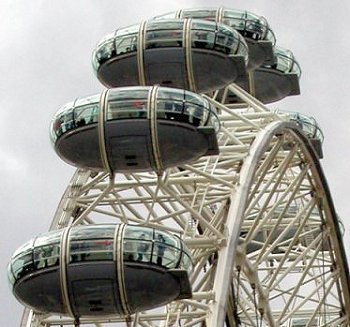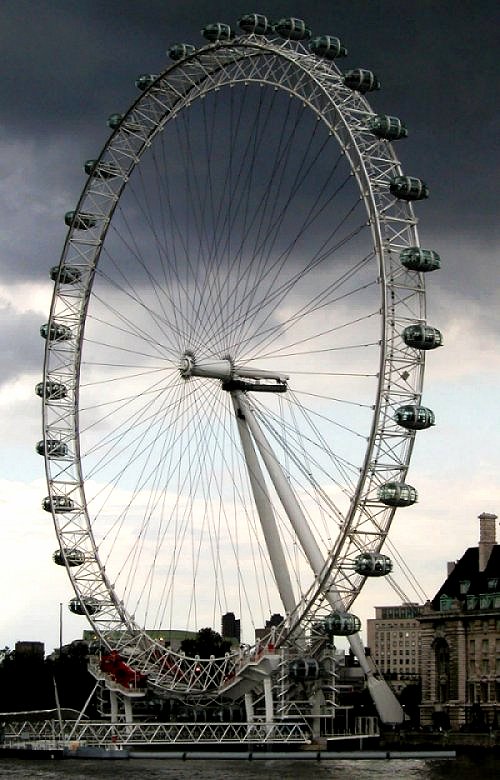The London Eye
Today, the London Eye. The University of Houston's College of Engineering presents this series about the machines that make our civilization run, and the people whose ingenuity created them.
Years ago, I did a program on the original 1893 Ferris Wheel -- a wondrous machine. It embodied the very soul of invention, because its purpose was simply to give pleasure -- probably as much to its inventor as to its riders. (Well, it was also meant to be America's answer to the Eiffel Tower.)
Back then I reported that Ferris's 250-foot diameter wheel had never been outdone. Now, on a June day in 2004, my wife and I have just visited London's Greenwich Observatory. We stepped across the prime meridian, saw Harrison's famous longitude chronometers, and now a Thames River boat takes us back to Westminster.
Just beyond the Tower of London and London Bridge there suddenly looms the largest Ferris Wheel we've ever seen. It leaves me gaping. I didn't see it on my London map because it's not called a Ferris Wheel. It's called the London Eye. And now that I see it, I can almost forgive London for its failure to honor George Ferris. This London Eye is four hundred feet in diameter. Riders can see twenty five miles on a clear day (if such a day is to be found.)
 Thirty-two capsules carry up to eight hundred people through one thirty-minute rotation. They board each of these gel-cap-shaped space-age capsules as it slowly moves by. Yet, immense as it is, the London Eye has only half the capacity that Ferris's Wheel did. He took twenty minutes to load people; then he gave them a much shorter and faster ride.
Thirty-two capsules carry up to eight hundred people through one thirty-minute rotation. They board each of these gel-cap-shaped space-age capsules as it slowly moves by. Yet, immense as it is, the London Eye has only half the capacity that Ferris's Wheel did. He took twenty minutes to load people; then he gave them a much shorter and faster ride.
Both wheels frightened people with their seeming flimsiness. The London Eye looks like a cosmic bicycle wheel with pods around the tire. Its delicate spokes are loaded only in tension. The wheel does not ride upon the spokes -- rather it hangsupon them.
That much was also true of Ferris's wheel. A month after it opened to passengers, Chicago suffered a terrible windstorm. Ferris seized that opportunity to take two people on a ride -- his wife and a reporter. The reporter later wrote,
As the mad storm swept round the cars the blast was deafening. It screamed through the thin spider-like girders, and shook the windows with savage fury. ... The inventor had faith in his wheel; Mrs. Ferris in her husband. But ... at that moment [I] believed neither in God nor man.
Now in London, my wife and I leave our boat to stroll around this Ezekiel wheel, fading up into the lowering sky above. No use riding it -- this day, we'd have seen very little from the top.
Across the river, Parliament and Big Ben remain -- a century-and-a-half old, with some sections that've been there for nine hun-dred years. But, that evening, TV focuses upon the wheel. We watch a reporter and a maintenance engineer climbing a ladder in-side one of its two hundred foot supporting struts to lubricate it.
So, at least for a while, London has its Eiffel Tower, its Chrysler Building, its Space Needle. It has its 21st-century personality, ascendant over St. Paul's Dome, Parliament, and all the rest. This great wheel now crowds them out of my mind. It may be short-lived, but it is a powerful icon for an old, old city.
I'm John Lienhard, at the University of Houston, where we're interested in the way inventive minds work.
The London Eye, heavily supported by British Airways, is not a permanent structure. But it is nevertheless being widely promoted as a new symbol of London. For more on the Eye, see:
https://www.londoneye.com/
The quote about George Ferris is from Terry Hogan. See the following fine website: https://www.thezephyr.com/archives/bigwheel.htm

The London Eye (both photos by John Lienhard)